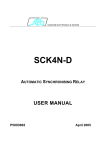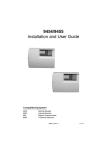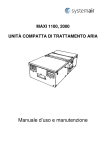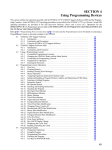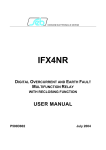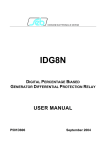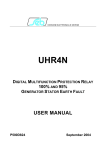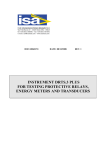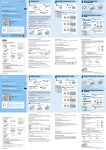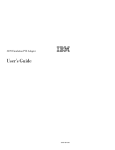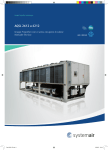Download USER MANUAL - seb barlassina
Transcript
DIVISIONE ELETTRONICA E SISTEMI SCK4N AUTOMATIC SYNCHRONISING RELAY USER MANUAL P500D814 August 2004 SEB Divisione Elettronica e Sistemi INDEX INDEX 1 2 3 4 5 6 7 8 GENERAL CHARACTERISTICS..................................................................................1 1.1 VOLTAGE CHECK – DEAD BUS operating mode ................................................4 1.2 SYNCHRO - CHECK operating mode ...................................................................5 1.3 SYNCHRONIZER operating mode ........................................................................7 FRONT PANEL KEYS ................................................................................................10 FRONT PANEL LED SIGNALLING ............................................................................11 PROGRAMMING AND TEST .....................................................................................12 4.1 How to program the protection relay....................................................................12 4.2 How to modify a visualized parameter.................................................................13 4.3 Reset ...................................................................................................................13 4.4 Test of output relays ............................................................................................14 DISPLAY AND PROGRAMMING ...............................................................................15 5.1 Standard display..................................................................................................15 5.2 Visualization structure .........................................................................................17 5.3 Operating modes (fig. 1)......................................................................................20 5.4 Address and time (fig. 1) .....................................................................................20 5.5 Nominal values set-up (fig. 1) ..............................................................................21 5.6 General set-up (fig. 2)..........................................................................................22 5.7 Set-up VOLTAGE CHECK DEAD BUS - LT ........................................................24 5.8 Set-up SYNCHRO-CHECK - PS .........................................................................26 5.9 Set-up - SYNCHRONIZER - PA ..........................................................................28 5.10 Output relays programming (fig. 2) ......................................................................33 5.11 Digital inputs function programming (fig. 2) .........................................................36 5.12 Special function programming (fig. 2) ..................................................................38 5.13 Signals visualization (fig. 3) .................................................................................38 5.14 Events (fig. 3) ......................................................................................................41 5.15 Trip counters (fig. 3) ............................................................................................46 INSTALLATION ..........................................................................................................47 6.1 Supplied kit ..........................................................................................................47 6.2 Cabling ................................................................................................................48 6.3 Relays R3 and R4 - Signalling / Command set-up ..............................................51 6.4 RS485 serial communication port........................................................................51 TECHNICAL CHARACTERISTICS.............................................................................52 TABLE ........................................................................................................................53 Information printed in this manual subject to change without prior notice. This manual must not be reproduced in whole or in part, in any form or by any means without the express written permission of SEB Divisione Elettronica e Sistemi. SEB Divisione Elettronica e Sistemi 1 GENERAL CHARACTERISTICS GENERAL CHARACTERISTICS The unit SCK4N performs functions as automatic synchronizing and coupler device (jointly with the CU90N for voltage equalizing) and as synchro-check relay in high voltage or medium voltage systems. The user can select one or more of the functional modes listed below: Functions ANSI Voltage check - dead bus - LT 25 Synchro-check - PS 25 Synchronizer - PA 25 Under all functional modes the unit measures two voltages (the reference voltage Ur and the controlled voltage Uc) and depending on the selected functional mode, from the programmed parameters and the parameters of the measured voltages (voltage difference, phase-angle, voltage slipping etc.) the unit deliver the closing command to the circuit breaker or the commands to the speed governor of a generator (only when Synchronizer mode is selected). All the functions of the unit are fully programmable by front panel keyboard or through a RS485 serial interface using a personal computer with set-up program; furthermore the relay can be programmed through a remote control and monitoring system. OPERATING MODES - the SCK4N unit manages the following functional modes: • voltage check - dead bus (LT) • synchro-check (PS) • automatic synchronizer (PA) It can be selected one or more operating modes; in the last case the selection of the operating mode is done automatically by the unit as function of the measured parameters. Specifically, the selection between the LT operating mode and the PS or PA operating modes is guaranteed by appropriate constraints between the thresholds of voltage absence/presence used by the LT mode and the threshold of minimum voltage difference used by PS and PA modes. The selection between the PS mode and the PA mode is based on the measurement of the voltage slipping between the measured voltages Ur and Uc. It is possible to define each measured voltage available (U1, U2, U3, U4) as reference voltage (Ur), controlled voltage (Uc) or no functions (OFF). Therefore it is possible to have more than one measured voltage for reference voltage Ur or controlled voltage Uc and to enable or disable the measuring channels (U1, U2, U3, U4) using an external command (digital input). 1 SEB Divisione Elettronica e Sistemi GENERAL CHARACTERISTICS The closing command can be delivered directly to the circuit breaker (impulsive command) or to a control unit which will manage the closing command to the circuit breaker (continue command as closing enable signal). The programmable values of the thresholds are listed in Table A. OUTPUT RELAYS - the SCK4N unit controls 4 output relays (named R1, R2, R3 and R4); these relays can be programmed to be activated on START or TRIP conditions of one or more thresholds. START instantaneous activation of the output relay when at least one of the measured voltages exceeds the programmed threshold value (e.g. voltage presence U>, voltage difference DUs< etc.) TRIP activation of the output relay to deliver closing command to the circuit breaker or TRIP related to threshold U>>. The quiescent state of each single relay R1, R2, R3 and R4 can be programmed as normally energized (ON) or normally de-energized (OFF). An additional relay R5 (normally energized) is controlled by the self-diagnosis routines to report detected fault conditions. Partial and total counters of the output relay activation (on TRIP conditions or closing command delivered to the circuit breaker) are available. DIGITAL INPUTS - there are available 3 digital inputs to activate the following functions (when enabled by the programmed set-up): • additional time delay on circuit breaker closing commands • on/off operating modes • on/off thresholds • on/off commands to the speed governor • selection of voltages (reference and controlled) • STATUS function (recording of measures on external event) • pilot wire fault monitoring (DIG2 only) • temporary operations For each digital input can be programmed the condition that activates the related functions: HI voltage = LO voltage = > 20 V dc / ac 0 ÷ 10 V dc / ac The digital input acquisition is valid when the voltage value stays in the range HI or LO for at least 40 ms. 2 SEB Divisione Elettronica e Sistemi GENERAL CHARACTERISTICS DISPLAY OF MEASURES - the user can select the continuous display of a measured parameter such as: • reference voltage or controlled voltage • frequency of the reference voltage or of the controlled voltage • voltage difference • phase angle between the measured voltages • slipping between the measured voltages • derivative slipping between the measured voltages EVENTS - information related to the last 6 events (TRIP or COMMAND delivery or STATUS) are recorded in the EEPROM memory. Information includes the measured parameters, the programmed parameters, the digital input status, date and time of the event. SELF-DIAGNOSIS - the software includes a continuous monitoring module that controls the functionality of all hardware and software resources of the protection relay. Detected fault conditions are reported by: • diagnostic message on the display • glow of a red LED on front panel • R5 output relay drop-off The fault condition signalling stays until faults are pointed out by the monitoring module; during this condition the protection functions are suspended to avoid unsuitable command delivery. STATUS FUNCTION - when the STATUS function is activated by one of the digital input (when programmed) the SCK4N unit memorizes information related to measured voltages and digital input status (see par. 5.14 - EVENTS). The recorded information allows an analysis of trip causes in co-operative protection relays systems. PILOT WIRE FAULT MONITORING - when the function is programmed, the digital input DIG2 is used to control the correct functionality of the pilot wire. Digital input DIG2 is always expected to be complementary of DIG1 input (HI-LO or LO-HI) to identify faults on pilot wire. The fault condition is reported as detected by the self-diagnosis module but the protection functions are not suspended; only the functions related to DIG1 digital input are suspended as the DIG1 status cannot be longer considered as true. The fault condition is reported when DIG1 and DIG2 signals are not complementary for more then 100 ms. 3 SEB Divisione Elettronica e Sistemi GENERAL CHARACTERISTICS REMOTE COMMUNICATION - the opto-insulated serial port RS485 can communicate with a personal computer or a remote control and monitoring system equipped with an RS485 interface or with a standard RS485/RS232 converter. It is possible to select the communication standard between STANDARD (ASCII 7 bit Seb protocol) or MODBUS (ASCII mode, SLAVE). All the set-up and measured parameters can be transmitted on the RS485 communication serial port; when communication is active (LED REMOTE glows), the operator on front panel can visualize the relay set-up but changes of parameters are disabled (ENTER and buttons disabled). 1.1 VOLTAGE CHECK – DEAD BUS operating mode This operating mode is used to connect two electrical systems (bus-bars or lines) of which at least one of them is dead (without voltage) No synchro-check functions are performed; it is performed only a check of absence/presence of voltages. The issue of the closing command to the circuit breaker (paralleling) is provided with a programmable time delay to avoid unsuitable command issue. When one of the measured voltages exceeds a programmable threshold, the operation will be disabled. When the unit is programmed as the voltage check - dead bus operating mode it will measure 2 voltages, one named Ur (reference voltage) and one named Uc (controlled voltage); the two voltages can be line voltages or phase voltages. The SCK4N unit compares both voltages with three programmable thresholds: voltage absence threshold voltage presence threshold overvoltage threshold (function inhibition) U< U> U>> Three functional modes can be selected: 1) 2) 3) LT Ur> LT Uc> LT Ur,c< paralleling in presence of only Ur voltage paralleling in presence of only Uc voltage paralleling in absence of both Ur and Uc (Ur> Uc< - rif. E2LT) (Ur< Uc> - rif. E3LT) (Ur< Uc< - rif. E4LT) With reference to the above functional modes, for each mode the condition to start (starting condition) the time delay Tlt (definite time) and the issue of the paralleling command when the time delay expire are the followings: 1) LT Ur> Ur presence [Ur > (U>)] Uc absence [Uc < (U<)] (overcoming threshold U>) (overcoming threshold U<) 2) LT Uc> Ur absence [Ur < (U<)] Uc presence [Uc > (U>)] (overcoming threshold U<) (overcoming threshold U>) 3) LT Ur,c< Ur absence [Ur < (U<)] (overcoming threshold U<) 4 SEB Divisione Elettronica e Sistemi GENERAL CHARACTERISTICS Uc absence [Uc < (U<)] (overcoming threshold U<) In the programming session it is possible to enable each of the functional modes. If one or both the measured voltages overcome the threshold U>>, the SCK4N unit will disable the issue of the paralleling command. The user can select the paralleling command mode as pulse command (programmable length Tcom) or as continuous command (as long as the start conditions are present); in the last case the duration of the command is equal to Tcom at least. When the starting condition disappears or when the pulse command is issued, the time delay Tlt is reset. Only when the pulse command mode is selected, if the paralleling condition are still present after a command issue, a new paralleling command will be issued after a time delay Tlt. In pulse command mode, when the paralleling condition are present, Tlt represents the time delay before the issue of the first command and the time delay between two consecutive paralleling commands. The issue of consecutive paralleling commands must be disabled by using an external control signal (digital input) from the circuit breaker (circuit breaker closed – paralleling operation completed) or to enable the paralleling operation for a definite time period (see paragraph 5.12 – Special functions). By using an external command (digital input) it is possible to increase of TAlt seconds the programmed time delay Tlt. NOTE: in the programming session the SCK4N unit verifies that: the threshold value the threshold value U< must be less than - U> / 1.2 U>> must be greater then - 1.2 * U> When one or more of the above conditions are not verified, an error message will be displayed at the end of the programming session. 1.2 SYNCHRO - CHECK operating mode This operating mode is used to connect two electrical systems (bus-bars or lines) both energized. The SCK4N unit verifies the synchronism condition and the voltage difference between the voltages of the two electrical systems; the issue of the closing command to the circuit breaker (paralleling) is provided with a programmable time delay to avoid unsuitable command issue. When one of the measured voltages exceeds a programmable threshold, the operation will be disabled. When the unit is programmed as synchro-check operating mode it will measure 2 voltages, one named Ur (reference voltage) and one named Uc (controlled voltage); the two voltages can be line voltages or phase voltages. 5 SEB Divisione Elettronica e Sistemi GENERAL CHARACTERISTICS The SCK4N unit compares the voltages with the following programmable thresholds: Ur voltage presence threshold overvoltage threshold (function inhibition) U> U>> Uc overvoltage threshold (function inhibition) U>> If one or both the measured voltages overcome the U>> threshold, the paralleling command issue will be disabled. From the measurement of the 2 voltages the unit will compute (in absolute value): • the voltage difference DU • the phase angle between the voltages Φ • the voltage slipping S To start (starting condition) the time delay Tps (definite time) and to allow issue of the paralleling command when the time delay expire ALL the followings must be verified (at the same time): 1) Ur present Ur > (U>) (overcoming threshold U>) 2) DU < DUs (overcoming threshold DUs<) 3) Φ < Φs (overcoming threshold Φs<) 4) S < Ss (overcoming threshold Ss<) The user can select the paralleling command mode as pulse command (programmable length Tcom) or as continuous command (as long as the start conditions are present); in the last case the duration of the command is equal to Tcom at least. When the starting condition disappears or when the pulse command is issued, the time delay Tps is reset. Only when the pulse command mode is selected, if the paralleling condition are still present after a command issue, a new paralleling command will be issued after a time delay Tps. In pulse command mode, when the paralleling condition are present, Tps represents the time delay before the issue of the first command and the time delay between two consecutive paralleling commands. The issue of consecutive paralleling commands must be disabled by using an external control signal (digital input) from the circuit breaker (circuit breaker closed – paralleling operation completed) or to enable the paralleling operation for a definite time period (see paragraph 5.12 – Special functions). 6 SEB Divisione Elettronica e Sistemi GENERAL CHARACTERISTICS By using an external command (digital input) it is possible to increase of TAps seconds the programmed time delay Tps. NOTE: if the operation mode LT (voltage check – dead bus) is also enabled, in the programming session the SCK4N unit verifies that: programmed threshold DUs must be ≤ 0.8 * [(U>) - (U<)] When the above condition is not verified, an error message will be displayed at the end of the programming session. 1.3 SYNCHRONIZER operating mode This operating mode is used to connect a synchronous generator to an electrical system (bus-bars or lines) The SCK4N unit verifies the synchronism condition and the voltage difference between the voltages of the two electrical systems; the issue of the closing command to the circuit breaker (paralleling) is provided with a programmable time delay to avoid unsuitable command issue. When one of the measured voltages exceeds a programmable threshold, the operation will be disabled. To avoid excessive stress to the generator, the closing command signal to the circuit breaker is delivered with lead condition (Φant lead angle) computed as function of the voltage slipping S and of the circuit breaker operating time Tmnv in order to close the circuit breaker poles on the synchronism condition. The SCK4N unit compares the voltages with the following programmable thresholds: Ur voltage presence threshold overvoltage threshold (function inhibition) U> U>> Uc overvoltage threshold (function inhibition) U>> If one or both the measured voltages overcome the U>> threshold, the paralleling command issue will be disabled. From the measurement of the 2 voltages the unit will compute (in absolute value): • the voltage difference DU • the phase angle between the voltages Φ • the voltage slipping S • the voltage slipping derivative dS/dt To start (starting condition) the time delay Tpa (definite time) and to allow issue of the paralleling command when the time delay expire ALL the following conditions must be verified (at the same time): 7 SEB Divisione Elettronica e Sistemi GENERAL CHARACTERISTICS 1) Ur present Ur > (U>) (overcoming threshold U>) 2) DU < DUa (overcoming threshold DUa<) 3) S < Sa (overcoming threshold Sa<) dS dSa < dt dt 4) (overcoming threshold dSa<) An additional condition to allow the issue of the paralleling command (programmable command length Tcom, issued when the lead angle between the two voltages is equal to Φant) is the following: dΦ 5) dt <0 (the phase angle between the voltages is decreasing) The threshold dSa< is computed by using the formula: dSa< = Ks * (Tk - Tmnv - 0.04) where: Ks Tk Tmnv programmable constant time base (programmable) circuit breaker operating time (programmable) Note: the threshold dSa/dt< can be disabled. By using an external command (digital input) it is possible to increase of TApa seconds the programmed time delay Tpa. When the starting condition disappears or when the pulse command is issued, the time delay Tps is reset. If the paralleling condition are still present after a command issue, a new paralleling command will be issued after a time delay Tpa. When the paralleling condition are present, Tps represents the time delay before the issue of the first command and the time delay between two consecutive paralleling commands. The issue of consecutive paralleling commands must be disabled using an external control signal (digital input) from the circuit breaker (circuit breaker closed – paralleling operation completed) or to enable the paralleling operation for a definite time period (see paragraph 5.12 – Special functions). NOTE If the operation mode PS (synchro-check) is also enabled, in the programming session the SCK4N unit verifies that: 8 SEB Divisione Elettronica e Sistemi GENERAL CHARACTERISTICS (Sa<) > 1.2 * (Ss<) and the overcome of the threshold Ss< enables the PS operating mode instead of PA operating mode. If the operation mode LT (voltage check – dead bus) is also enabled, in the programming session the SCK4N unit verifies that: programmed threshold |DUa must be ≤ 0.8 * [(U>) - (U<)] When the above conditions are not verified, an error message will be displayed at the end of the programming session. Generator speed governor commands Two output relays can be programmed to deliver commands to the speed governor of the generator (AUM - accelerate, DIM - decelerate) as function of the negative or positive sign of the voltage slipping or, under specific condition, as function of the phase angle between the measured voltages. The commands length Treg is programmable; they are issued with time cadence Ti (programmable) until the threshold |Sa|< is overcame (voltage slipping small enough). The time cadence Ti of the command issue can be programmed as time definite or time dependent (as inverse function of the voltage slipping). The issue of commands to the speed governor is forced when both the |Sx|< and Φx> threshold are overcame (programmable thresholds); these thresholds are defined to avoid stand-by conditions of the paralleling system in presence of a large phase-angle when the voltage slipping is zero or very low (very long time to wait the paralleling condition). This functionality is automatically disabled when the (PS + PA) and (LT + PS + PA) operating mode are selected. These forced command are issued with Tx time delay (programmable, time definite). The issue of commands to the speed governor can be inhibited when the absolute value of the voltage slipping overcomes a programmable threshold |Sm|>; the inhibition function can be disabled through the keyboard or by using and external signal (digital input). The time delay between two consecutive commands cannot be shorter than a time delay Tim (programmable) to guarantee the proper acquisition by the speed governor. If one or both the measured voltages overcome the U>> threshold, the speed governor command issue will be disabled. 9 SEB Divisione Elettronica e Sistemi 2 FRONT PANEL KEYS FRONT PANEL KEYS The 5 push-buttons on the front panel allow to visualize all the protection parameters and to modify the protection set-up. right arrow down arrow programming session activation or parameter confirmation ENTER change or increment of the selected parameter RESET reset of the protection relay (ref. par. 4.3) VISUALIZATION OF PARAMETERS • all visualizations are circular and they can be displayed using the two arrow pushbuttons. • the structure of the visualizations and their contents are showed in Figures 1, 2 and 3. • when the sealable transparent front panel is installed only the arrow push-buttons and the RESET push-button are accessible to prevent unauthorized modification of the protection set-up. MODIFICATION OF PARAMETERS • remove the transparent sealable front panel to access ENTER and buttons. 10 push- SEB Divisione Elettronica e Sistemi 3 FRONT PANEL LED SIGNALLING FRONT PANEL LED SIGNALLING POWER (green) ⊕ auxiliary supply available FAIL (red) ⊕ fault condition detected by SELF-DIAGNOSIS software or by PILOT WIRE FAULT MONITORING function REMOTE (red) ⊕ communication session active on RS485 port LT U>> (red) ⊕ issue paralleling command with Voltage-check dead bus mode and/or trip threshold U>> PS U>> (red) ⊕ issue paralleling command with Synchro-check mode and/or trip threshold U>> PA U>> (red) ⊕ issue paralleling command with Synchronizing mode and/or trip threshold U>> The last trip condition (threshold indication) is also showed on front panel display; more information on trip condition are presented in the recorded EVENT (see par. 5.14). 11 SEB Divisione Elettronica e Sistemi 4 PROGRAMMING AND TEST PROGRAMMING AND TEST The SCK4N unit is easily programmable following the instructions in the next paragraphs: • • HOW TO PROGRAM THE PROTECTION RELAY HOW TO MODIFY A VISUALIZED PARAMETER All parameters can be freely modified; the proper protection set- up as required by the plant management is submitted to the operator's judgment. 4.1 How to program the protection relay The programmable parameters are showed in Figures 1, 2 and 3 at the following references: B2÷B6 C1÷C4 D1÷D5 E1LT÷E8LT E1PS÷E7PS E1PA÷E16PA F1÷F16 G1÷G3 H1-H2 R1÷R20 relay address (RS485) and date/time nominal values, display etc. general set-up set-up voltage-check dead bus mode (LT) set-up synchro-check mode (PS) set-up synchronizing mode (PA) output relays functions digital input functions special functions partial trip counters reset The programming sequence is the following: 1) SELECT the visualization (on display) of the parameter to be modified using the arrow push-buttons 2) ACTIVATE the PARAMETER MODIFICATION session depressing the [ENTER] push-button and modify the parameter value 3) END the parameter modification session depressing again the [ENTER] pushbutton 4) REPEAT the procedure from 1) to 3) for all the parameters required to obtain the new unit set-up 5) CONFIRM the new protection relay set-up at the visualization CONFIRM PROG? (Fig. 1, ref. J1) within 5 minutes depressing the push-buttons [ENTER], up to visualize YES and [ENTER] again to confirm. NOTE: The unit will continue to operate using the previous set-up until the new set-up is confirmed as at point 5) above; the visualization of the modified parameters before the new set-up confirmation is only temporary to allow an easy definition of the new set-up. If the new set-up is not confirmed within 5 minutes from the last pressed push-button, the SCK4N unit visualizes again the previous set-up (the parameters set-up that the unit is still using). 12 SEB Divisione Elettronica e Sistemi 4.2 PROGRAMMING AND TEST How to modify a visualized parameter When the parameter to be modified is visualized on front panel display do the following sequence: 1) PRESS [ENTER] to activate the parameter modification session If one or more parameters are modifiable, on the first of them will appear a blinking cursor. If no parameters are modifiable, no blinking cursor will appear. 2) MODIFY THE PARAMETER pressing the arrow push-buttons and when two parameters are modifiable, the push-button allows to point-out the parameter to be modified (the selected parameter will blink) when numerical parameters are pointed-out the push-button allows to select the digit to be modified increasing of the parameter 3) a) the digits are increased by 1 unit b) the other parameters are presented following the selection list PRESS [ENTER] to end parameter modification session The modification session is ended and the parameter stops to blink NOTE: if a numerical parameter is selected out of the accepted range (as shown in Table A) when the push-button [ENTER] is pressed for few seconds an error message will be displayed as: Data Error and the parameter will be displayed again with the former value. 4.3 Reset When the push-button [RESET] is pressed, the unit returns to the standard condition: • reset of glowing LEDs • drop-off of tripped relays • reset of any parameter changed but not confirmed (parameters are shown as confirmed at the end of the last programming session) 13 SEB Divisione Elettronica e Sistemi • 4.4 PROGRAMMING AND TEST display on STANDARD MODE (Fig. 1, ref. A1 - par. 5.1) Test of output relays When the output relays test is selected (Fig. 2, ref. F16) it is possible to command an output relay (one at the time) to trip from the current status allowing functional tests on electrical plants. The output relays are activated with the following sequence: 1) SELECT THE VISUALIZATION of the desired output relay to be tested TEST R1 OFF 2) PRESS [ENTER] to activate the test session; the message OFF will start to blink. 3) PRESS and the message on the display will change as: TEST R1 ON 4) PRESS [ENTER] to command the instantaneous trip of the output relay (change of the current status). The relay will stay on the new condition until: • the • the [ENTER] push-button is pressed and the sequence at points 3) and 4) is repeated (presenting OFF condition) or [RESET] push-button is pressed The same procedure will be used for R2, R3 and R4 relays. 14 SEB Divisione Elettronica e Sistemi 5 DISPLAY AND PROGRAMMING DISPLAY AND PROGRAMMING The contents and the structure of the displayed messages are shown in figures 1, 2 and 3; the references A1, B1, B2 etc. identify specific displayed messages in the figures. 5.1 Standard display A1 - STANDARD DISPLAY It is the standard displayed message without operator's intervention (no push-buttons pressed for at least 5 minutes) or when the RESET push-button has been pressed. The displayed information is function of the unit status. NORMAL FUCTIONING During this state the following information can be visualized (as defined by set-up): • Protection function (ANSI code) - the display shows the code ANSI 25 • Measured voltages and parameters - the display shows one of the measured parameters (voltages or related parameters); the information to be visualized is selected by operator (ref. C3) and it is function of the selected operative mode. PARALLELING COMMAND ISSUE When a paralleling command is issued (or when the U>> threshold is overcame) the unit visualizes a TRIP message that includes the operating mode related to the issued paralleling command (as more than one operating mode can be programmed as active) or the threshold related to the trip; the displayed messages are as the following: TRIP PA TRIP PS TRIP U>> TRIP LT The information of the trip, as well the glowing of the related LEDs, is displayed until the [RESET] push-button is pressed. If a new trip condition occurs, the displayed information will be updated; information related to previous trips are recorded in EVENTS memory. FAULT CONDITION When a permanent or temporary fault condition is detected by the self-diagnosis module, the following message is displayed: FAIL eeeeeeee The string eeeeeeee can be: F.PILOT Detected fault condition on pilot wire; the function related to DIG1 digital input is suspended Corrective action - verify pilot wire (short or open circuit) 15 SEB Divisione Elettronica e Sistemi HARDWARE DISPLAY AND PROGRAMMING Detected fault condition on hardware or software resources of the protection relay; all functions are suspended. Corrective action - replace the unit and contact SEB post sales service 16 SEB Divisione Elettronica e Sistemi 5.2 DISPLAY AND PROGRAMMING Visualization structure A1 ANSI 25 B1 SCK4N mod 4T A2 FUNCTION aaaaaaaa SET-UP ALTERNATIVE DISPLAYS B2 PROTOCOL yyyyyyyy B3 BAUDRATE nnnn FAIL eeeeeeee TRIP PA TRIP LT B4 NR RELAY xxx B5 SER. NR. zzzzzzzz SW REV zz.zz B6 LT, PS, PA, LT+PS, LT+PA, LT+PS+PA NOMINAL VALUES NOMINAL DATA (FIG. 2) GENERAL SET-UP GENERAL PARAMETERS set-up (FIG. 2) SET-UP LT VOLTAGE CHECK – DEAD BUS set-up (FIG. 2) SET-UP PS SYNCHRO CHECK set-up (FIG. 2) SET-UP PA SYNCHRONIZER set-up (FIG. 2) RELAYS FUNCTION OUTPUT RELAYS set-up (FIG. 2) DIGITAL INPUTS DIGITAL INPUT set-up (FIG. 2) SPECIAL FUNCTION SPECIAL FUNCTION set-up (FIG. 2) J1 CONFIRM PROG?.. MEASURES & EVENTS SIGNAL STATUS Display of SIGNALS and OUTPUT RELAYS status (FIG. 3) EVENTS Display of EVENTS data (FIG. 3) COUNTERS Display of COUNTERS data (FIG. 3) Figure 1 17 TRIP PS B7 dd/mm/yy hh:mm:ss TRIP U>> To FIGURE 3 From FIGURE 1 SET-UP 18 F5 R1 Uc> xxxxxxxx E4PA Ks d.d %/s2 F4 R1 Ur< xxxxxxxx E3PA dSa< ccc Tk.rr s F3 R1 Ur> xxxxxxxx E2PA Sa< f.ff % F2 R1 U>> xxxxxxxx E1PA DUa< .uu xxxxxx V F1 R1 NORM ccc SET-UP PA RELAYS FUNCTION CONFIRM PROG?.. H2 H1 ENABLE TEMP ccc SPECIAL FUNCTION Tabil zzz s G2 DIG2 cc xxxxxxxx G1 DIG1 cc xxxxxxxx DIGITAL INPUTS R4 NORM ccc R3 NORM ccc Figure 2 E5PA Tmnv k.kk s E4PS Tps IND zz.zz s E3PS s< bb° E2PS Ss< a.aa % E1PS DUs< .uu xxxxxx V SET-UP PS G3 DIG3 cc xxxxxxxx E5PS COM ps vvvvvvvv E4LT Ur< Uc< ccc E3LT Ur< Uc> ccc E2LT Ur> Uc< ccc E1LT U< n.nn xxxxxx V SET-UP LT R2 NORM ccc E5LT Tlt IND zz.zz s D4 U3 qqq U4 qqq D3 U1 qqq U2 qqq D2 U>> n.nn xxxxxx V D1 U> n.nn xxxxxx V GENERAL SET-UP D5 Tcom k.kk s C4 CONTRAST LEV n C3 DISPLAY eeeeeeee C2 Un prim xxxxxx V C1 Un= xxx.xx V NOMINAL VALUES F6 R1 Uc< xxxxxxxx E13PA E12PA Sx< ccc a.aa % F8 R1 DUa< xxxxxxxx F13 R1 Sm> xxxxxxxx F7 R1 DUs< xxxxxxxx F12 R1 AVTpa xxxxxxxx x> bb° E8PA TApa PA gggggggg E8LT TAlt LT gggggggg E7PA TApa PA yy.yy s E7PS TAps PS gggggggg E6PS TAps PS yy.yy s E6PA Tpa IND zz.zz s E7LT TAlt LT yy.yy s E6LT COM lt vvvvvvvv E9PA F14 R1 AUM xxxxxxxx F9 R1 COM xxxxxxxx E14PA Ti hhhhh mmm.mm s REG ccc F15 R1 DIM xxxxxxxx F10 R1 AVTlt xxxxxxxx E15PA Tim IND zz.zz s E10PA Treg e.ee s F16 TEST R1 yyyyyyyy F11 R1 AVTps xxxxxxxx E16PA Tx IND zz.zz s E11PA Sm> ccc p.pp % SEB Divisione Elettronica e Sistemi DISPLAY AND PROGRAMMING From FIGURE 2 MEASURES & EVENTS COUNTERS EVENTS SIGNALS STATUS L6 19 U>> P eeee R1 E6 aaaaaaaa R2 LT Ur> P eeee R3 LT Ur> T eeee LT Uc> P eeee Figure 3 R4 R5 LT Uc> T eeee R6 R7 LT Ur,c< P eeee Q37 E1 Time hh:mm:ss Q36 E1 Date dd/mm/yy Q35 E1 DIG3 vv Q34 E1 DIG2 vv Q33 E1 DIG1 vv Q32 E1 dS +.rr %/s U>> T eeee Q27 E1 Fr zz.zz Hz Q26 E1 Ur Uq y.yy Un Q25 E1 DIG eeeeeeee Q24 E1 T-TOT www.ww s R11 PA P eeee R15 TIME PRG hh:mm:ss R14 DATE PRG dd/mm/yy R13 TOT PRG cccc R12 PA T eeee Q31 R10 PS T eeee E1 +hh° Q21 E1 Sx< a.aa % Q11 E1 Tmnv k.kk s R9 Q30 E1 S +f.ff % Q20 E1 Sx< ccc Q10 E1 Sa< a.aa % PS P eeee Q29 E1 DU +.yy Un Q19 E1 Sm> a.aa % Q9 E1 DUa< x.xx Un +bbb° P9 dS +.ee %/s L15 Sx< status L14 Sm> status L13 dSa< status P8 L10 PA status L9 PS status L8 LT status R8 LT Ur,c< T eeee Q28 E1 Uc Uq y.yy Un Q18 E1 Sm> ccc Q17 E1 REG ccc Q16 E1 COM vvvvvvvv Q15 E1 Tcom k.kk s Q14 E1 Tk k.kk s Q13 E1 Ks d.d %/s2 Q12 E1 dSa> ccc Q23 E1 RELAY i,j,k Q8 E1 Os< bb° Q7 E1 Ss< a.aa % Q6 E1 DUs< x.xx Un Q5 E1 U< x.xx Un Q4 E1 U> x.xx Un Q3 E1 U>> x.xx Un Q2 E1 ppp nnnnnnnn Q1 E1 cccccccc Q22 E1 x> bb° P7 S +f.ff % L12 REG status L7 LT Ur,c< status P6 DU +x.xx +yyyyy V L11 AB TEMP status LT Uc> status P5 Fc dd.dd Hz L5 P4 Uc x.xx yyyyyy V LT Ur> status P3 Fr dd.dd Hz L4 P2 Ur x.xx yyyyyy V U4 status P1 L3 Ur=Uq Uc=Uq U3 status INPUTS STATUS N2 DIG3 ww N1 DIG1 ww DIG2 ww DIGITAL STATUS M2 R3 ccc R4 ccc M1 L2 R1 ccc R2 ccc U2 status RELAYS STATUS L1 U1 status FUNCTION STATUS SEB Divisione Elettronica e Sistemi DISPLAY AND PROGRAMMING SEB Divisione Elettronica e Sistemi 5.3 DISPLAY AND PROGRAMMING Operating modes (fig. 1) A2 - OPERATING MODE SELECTION (programmable) FUNCTION aaaaaaaa Selection of the operating modes of the SCK4N unit. The available selections (parameter aaaaaaaa) are the following: LT VOLTAGE-CHECK DEAD BUS (ref. par. 1.1) PS SYNCHRO CHECK (ref. par. 1.2) PA SYNCHRONISING (ref. par. 1.3) LT+PS VOLTAGE CHECK and SYNCHRO-CHECK operating mode LT+PA VOLTAGE CHECK and SYNCHRONIZING operating mode PS+PA SYNCHRO CHECK and SYNCHRONIZING operating mode LT+PS+PA VOLTAGE CHECK and SYNCHRO-CHECK and SYNCHRONIZING operating mode 5.4 Address and time (fig. 1) B1 - RELAY MODEL (not programmable) SCK4N mod. 4T B2 - COMMUNICATION PROTOCOL (programmable) B2 PROTOCOL xxxxxxxx The communication protocol is programmable between the followings: STANDARD ASCII SEB protocol MODBUS Modbus protocol (SLAVE) When the MODBUS protocol is selected the following display is showed to allow the selection of the transmission speed: B3 BAUDRATE xxxx The xxxx parameter is selectable between the followings: 300 - 600 - 1200 - 2400 - 4800 - 9600 20 SEB Divisione Elettronica e Sistemi DISPLAY AND PROGRAMMING When the STANDARD protocol is selected the baud rate is automatically selected by the protection relay. B4 - ADDRESS (programmable) NR RELAY 001 Programmable address from 001 to 255. The number is used on RS485 port to address a specific unit when two or more unit or protection relays are linked on the same serial line. B5 - RELAY SERIAL NUMBER (not programmable) SER. NR 0012345 B6 - SOFTWARE REVISION LEVEL (not programmable) SW REV zz.zz B7 - TIME / DATE (programmable) dd/mm/yy hh:mm:ss Time and date are programmable and they are used to mark recorded events. NOTE the clock is not provided with back-up battery, therefore a loss of auxiliary supply will force time/date to the following condition: 01/01/90 00:00:00 5.5 Nominal values set-up (fig. 1) C1 - NOMINAL LINE VOLTAGE SELECTION - Un (programmable) Un = xxx.xx V Un: nominal line voltage selection (nominal secondary voltage of plant VTs) selectable between the followings: 57,73 - 63,50 - 72,16 - 100 - 110 - 125 - 190 - 220 - 230 - 380 - 400 C2 - PRIMARY VTs LINE VOLTAGE (programmable) U prim xxxxxx V 21 SEB Divisione Elettronica e Sistemi DISPLAY AND PROGRAMMING Primary voltage value of the installed line VT’s; the value is programmable from 000001 to 999999 V. C3 - STANDARD DISPLAY SELECTION (programmable) DISPLAY eeeeeeee It allows to select the standard displayed information (ref. A1) when no trip condition occurs and no fault condition have been detected by the self-diagnosis module. The available selections are the following: ANSI Ur Uc Fr Fc DU ANGOLO S dS displays of ANSI code displays measured reference voltage displays measured controlled voltage displays frequency of the reference voltage displays frequency of the controlled voltage displays the difference between Ur and Uc voltages displays the phase-angle between Ur and Uc voltages displays the slipping between Ur and Uc voltages displays the slipping derivative The voltages are shown in primary values (as function of the set-up at ref. C2) Selection examples: DISPLAY ANSI DISPLAY Fr DISPLAY dS C4 - DISPLAY CONTRAST LEVEL (programmable) CONTRAST LEV x The display contrast level is programmable from 0 to 9. The backlighted display is switched off if no push-button is pressed for at least 5 minutes; when one of the front panel push- button is pressed the display is switched on. 5.6 General set-up (fig. 2) D1 - VOLTAGE PRESENCE THRESHOLD (programmable) U> n.nn xxxxxx V n.nn: xxxxxx: threshold value expressed as Un threshold value expressed as Volt The overcome of the threshold means presence of the voltage. For the programmable values please refer to table A. 22 SEB Divisione Elettronica e Sistemi DISPLAY AND PROGRAMMING D2 - OVERVOLTAGE THRESHOLD (programmable) U>> n.nn xxxxxx V n.nn: xxxxxx: threshold value expressed as Un threshold value expressed as Volt The overcome of the threshold disables the operations of SCK4N unit (paralleling command issue or commands to the speed governor). For the programmable values please refer to table A. The SCK4N unit verifies that the U>> threshold value must be programmed at least 1.2 times the value of the U> threshold. If the condition is not verified, an error message will be displayed during the programming session (at CONFIRM programming – ref. 4.1). D3 - D4 SELECTION OF THE MEASURED VOLTAGES (programmable) U1 qqq U2 qqq U3 qqq U4 qqq Selection of the measured voltages (referred to the input transducers U1, U2, U3 and U4, see insertion scheme) qqq can be programmed Ur Uc OFF reference voltage controlled voltage no functions More than one input transducer can be programmed for the same function, to allow paralleling operation in different points of the installation; in this case the proper operating voltage must be selected using the digital input (with specific set-up to enable the measure of a voltage – ref. G1, G2, G3 par. 5.11) NOTE: it is required that the secondary voltages of the different VT’s must be the same. Example: U1 Ur U2 Uc U3 Uc U4 OFF As function of the digital input, the SCK4N unit allow the paralleling command issue taking into consideration the voltage measured by the U2 transducer or the voltage measured by the U3 transducer. All VT’s connected to U1, U2 and U3 must have the same secondary nominal voltage. D5 - PARALLELING (CLOSING) COMMAND LENGTH (programmable) Tcom k.kk s k.kk length (seconds) of the command issued to close the circuit breaker. 23 SEB Divisione Elettronica e Sistemi DISPLAY AND PROGRAMMING The paralleling command (when pulse command mode is selected) will be issued activating the programmed output relay to close for Tcom seconds. For the programmable values please refer to table A. Example: Tcom 0.20 s 5.7 Set-up VOLTAGE CHECK DEAD BUS - LT E1LT - VOLTAGE ABSENCE THRESHOLD (programmable) U< n.nn xxxxxx V n.nn: xxxxxx: threshold value expressed as Un threshold value expressed as Volt The overcome of the threshold means absence of the voltage (DEAD BUS). For the programmable values please refer to table A. The SCK4N unit verifies that the U< threshold value must be programmed lower than the value U> / 1.2. If the condition is not verified, an error message will be displayed during the programming session (at CONFIRM programming – ref. 4.1). E2LT - E3LT - E4LT - FUNCTIONAL MODE SELECTION (programmable) Ur> Uc< ccc ccc Ur< Uc> ccc Ur< Uc< ccc ON - enabled functional mode OFF - disabled functional mode Selection of the functional mode related to VOLTAGE CHECK - DEAD BUS paralleling operations (refer to paragraph 1.1). More than functional mode can be enabled at the same time. Example: E2LT Ur> Uc< ON E3LT Ur< Uc> OFF E4LT Ur< Uc< ON If the Uc voltage is absent and the Ur voltage is present or the Uc and Ur voltages are both absent, the paralleling command will be issued. E5LT - TIME DELAY TO COMMAND ISSUE (programmable) Tlt IND xx.xx s 24 SEB Divisione Elettronica e Sistemi DISPLAY AND PROGRAMMING Set-up of the time delay to the paralleling command issue (for safe operations to avoid command issue with unstable conditions of the network). The time delay is definite time only. For the programmable values please refer to table A. E6LT - PARALLELING COMMAND MODE (programmable) COM lt vvvvvvvv vvvvvvvv: IMPULSIV - pulse command (length Tcom seconds - ref. D5) CONTINUO - continuous command With the CONTINUO selection the output relay of the SCK4N unit will remain activated (paralleling command) as long as the paralleling condition will be present. E7LT - ADDITIONAL TIME DELAY (programmable) TAlt LT xx.xx s An additional time delay TAlt will increase the programmed time delay Tlt (ref. E5LT) to obtain a total time delay to the command issue equals to Tlt+TAlt seconds. Please note that at least one of the digital inputs should be programmed to activate time delay function (ref. G1, G2, G3 – paragraph 5.11). For the programmable values please refer to table A. E8LT- DIGITAL INPUT ACTIVE ON ADDITIONAL TIME DELAY (not programmable) TAlt LT eeeeeee It shows the digital input programmed to activate the additional time delay TAlt. The parameter eeeeeeee can show one of the following values: DISABLED none of the digital inputs has been programmed to activate an additional time delay TAlt DIG1 digital input DIG1 activates the TAlt delay DIG2 digital input DIG2 activates the TAlt delay DIG3 digital input DIG3 activates the TAlt delay More than one digital input can activate the same additional time delay (e.g. DIG 1,3). Please note that to activate the additional time delay at least one of the digital inputs should be programmed (ref. G1, G2, G3 - paragraph 5.11). 25 SEB Divisione Elettronica e Sistemi 5.8 DISPLAY AND PROGRAMMING Set-up SYNCHRO-CHECK - PS E1PS - VOLTAGE DIFFERENCE THRESHOLD (programmable) DUs< .uu xxxxxx V Set-up of the maximum voltage difference (as absolute value) between the voltage Ur and the voltage Uc that will allow the issue of the paralleling command (if the voltage difference is greater than the programmed value the paralleling command issue will be disabled). .uu xxxxxx threshold value expressed as Un threshold value expressed as Volt If the LT (VOLTAGE CHECK - DAED BUS) mode is also enabled, the SCK4N unit will verify that the DUs< threshold value must be programmed lower than: 0.8 * (U> - U<) If the condition is not verified, an error message will be displayed during the programming session (at CONFIRM programming - ref. 4.1). For the programmable values please refer to table A. E2PS - SLIPPING THRESHOLD (programmable) Ss< a.aa % Set-up of the maximum slipping (as absolute value) between the voltage Ur and the voltage Uc that will allow the issue of the paralleling command (if the slipping is greater than the programmed value the paralleling command issue will be disabled). a.aa maximum allowed slipping as % of the frequency For the programmable values please refer to table A. E3PS - PHASE ANGLE THRESHOLD (programmable) Φs< bb° Set-up of the maximum phase angle (as absolute value) between the voltage Ur and the voltage Uc that will allow the issue of the paralleling command (if the phase angle is greater than the programmed value the paralleling command issue is disabled). bb maximum allowed phase angle (degree) For the programmable values please refer to table A. 26 SEB Divisione Elettronica e Sistemi DISPLAY AND PROGRAMMING E4PS - TIME DELAY TO COMMAND ISSUE (programmable) Tps IND xx.xx s Set-up of the time delay to the paralleling command issue (for safe operations to avoid command issue with unstable conditions of the network). The time delay is definite time only. For the programmable values please refer to table A. E5PS - PARALLELING COMMAND MODE (programmable) COM ps vvvvvvvv vvvvvvvv: IMPULSIV - pulse command (length Tcom seconds - ref. D5) CONTINUO - continuous command With the CONTINUO selection the output relay of the SCK4N unit will remain activated (paralleling command) as long as the paralleling condition will be present. E6PS - ADDITIONAL TIME DELAY (programmable) TAps PS xx.xx s An additional time delay TAps will increase the programmed time delay Tps (ref. E4PS) to obtain a total time delay to the command issue equals to Tps+TAps seconds. Please note that at least one of the digital inputs should be programmed to activate time delay function (ref. G1, G2, G3 - paragraph 5.11). For the programmable values please refer to table A. E7PS - DIGITAL INPUT ACTIVE ON ADDITIONAL TIME DELAY (not programmable) TAps PS eeeeeee It shows the digital input programmed to activate the additional time delay TAps. The parameter eeeeeeee can show one of the following values: DISABLED none of the digital inputs has been programmed to activate an additional time delay TAps DIG1 digital input DIG1 activates the TAps delay DIG2 digital input DIG2 activates the TAps delay DIG3 digital input DIG3 activates the TAps delay More than one digital input can activate the same additional time delay (e.g. DIG 1,3). 27 SEB Divisione Elettronica e Sistemi DISPLAY AND PROGRAMMING Please note that to activate the additional time delay at least one of the digital inputs should be programmed (ref. G1, G2, G3 - paragraph 5.11). 5.9 Set-up - SYNCHRONIZER - PA E1PA - VOLTAGE DIFFERENCE THRESHOLD (programmable) DUa< .uu xxxxxx V Set-up of the maximum voltage difference (as absolute value) between the voltage Ur and the voltage Uc that will allow the issue of the paralleling command (if the voltage difference is greater than the programmed value the paralleling command will not be issued). .uu xxxxxx threshold value expressed as Un threshold value expressed as Volt If the LT (VOLTAGE CHECK - DAED BUS) mode is also enabled, the SCK4N unit verifies that the DUa< threshold value must be programmed lower than: 0.8 * (U> - U<) If the condition is not verified, an error message will be displayed during the programming session (at CONFIRM programming - ref. 4.1) For the programmable values please refer to table A. E2PA - SLIPPING THRESHOLD (programmable) Sa< a.aa % Set-up of the maximum slipping (as absolute value) between the voltage Ur and the voltage Uc that will allow the issue of the paralleling command (if the slipping is greater than the programmed value the paralleling command will not be issued). a.aa maximum allowed slipping as % of the frequency For the programmable values please refer to table A. The SCK4N unit will verify if the threshold value Sa< is higher than: 1.2 * Ss< (slipping threshold PS - ref. E2PS) if the PS mode (Synchro-Check) is also enabled at the same time 1.2 * Sx< (slipping threshold to force command issue to the speed governor - ref. E12PA) If both conditions are not verified, an error message will be displayed during the programming session (at CONFIRM programming - ref. 4.1) Example: 28 SEB Divisione Elettronica e Sistemi DISPLAY AND PROGRAMMING Sa< 0.80 % E3PA - E4PA - E5PA - VOLTAGE SLIPPING DERIVATIVE THRESHOLD AND RELATED PARAMETERS (programmable) The voltage slipping derivative threshold is used to avoid paralleling command issue when the voltage slipping is changing too quickly therefore the command issue on the computed lead condition will not guarantee the circuit breaker closing on the synchronized condition. E3PA dSa< ccc Tk .rr s E4PA Ks d.d %/s2 E5PA Tmnv k.kk s Programming of the voltage slipping derivative threshold dSa< and its parameters to allow the SCK4N unit to compute it. ccc ON - enabled function OFF - disabled function .rr parameter Tk used in the computation of the maximum voltage slipping threshold (seconds) - suggested value 0.5 s d.d parameter Ks (expressed as %/s2) used in the computation of the maximum voltage slipping threshold - suggested value 1 %/s2 k.kk operating time (closing delay) of the paralleling circuit breaker used in the computation of the maximum voltage slipping threshold (seconds) dSa/dt< = Ks * (Tk - Tant) = Ks * (Tk - Tmnv - Tmis) Ks programmable parameter - ref. E4PA Tk programmable parameter Tmnv circuit breaker operating time - programmable - ref. E5PA Tmis 0.04 seconds - SCK4N unit measuring time For the programmable values please refer to table A. The SCK4N unit will verify if Tk is greater than Tmnv + 0.27 sec. If the condition is not verified, an error message will be displayed during the programming session (at CONFIRM programming - ref. 4.1). Example: E3PA dSa< ON Tk .50 s E4PA Ks 1.2 %/s2 E5PA Tmnv 0.15 s dSa/dt< = Ks * (Tk - Tmnv - Tmis) = 0.37 % / sec with Tk greater than 0.42 seconds (Tmnv + 0.27) 29 SEB Divisione Elettronica e Sistemi DISPLAY AND PROGRAMMING E6PA - TIME DELAY TO COMMAND ISSUE (programmable) Tps IND xx.xx s Set-up of the time delay to the paralleling command issue (for safe operations to avoid command issue with unstable conditions of the network). The time delay is definite time only. For the programmable values please refer to table A. E7PA - ADDITIONAL TIME DELAY (programmable) TApa PA xx.xx s An additional time delay TApa will increase the programmed time delay Tpa (ref. E4PS) to obtain a total time delay to the command issue equals to Tpa+TApa seconds. Please note that at least one of the digital inputs should be programmed to activate time delay function (ref. G1, G2, G3 - paragraph 5.11) For the programmable values please refer to table A. E8PA- DIGITAL INPUT ACTIVE ON ADDITIONAL TIME DELAY (not programmable) TApa PA eeeeeee It shows the digital input programmed to activate the additional time delay TApa. The parameter eeeeeeee can show one of the following values: DISABLED none of the digital inputs has been programmed to activate an additional time delay TApa DIG1 digital input DIG1 activates the TApa delay DIG2 digital input DIG2 activates the TApa delay DIG3 digital input DIG3 activates the TApa delay More than one digital input can activate the same additional time delay (e.g. DIG 1,3). Please note that to activate the additional time delay at least one of the digital inputs should be programmed (ref. G1, G2, G3 - paragraph 5.11) E9PA - E10PA - GENERATOR SPEED GOVERNOR COMMANDS (programmable) Enable/disable commands issue (AUM - accelerate, DIM - decelerate) to the generator speed governor and command length (seconds). E9PA REG ccc E10PA Treg e.ee s 30 SEB Divisione Elettronica e Sistemi ccc ON - enabled function OFF - disabled function e.ee command length (seconds) DISPLAY AND PROGRAMMING For the programmable values please refer to table A. E11PA - EXCESSIVE VOLTAGE SLIPPING THRESHOLD TO DISABLE COMMAND ISSUE TO THE SPEED GOVERNOR (programmable) Sm> ccc p.pp % ccc ON - enabled function OFF - disabled function p.pp voltage slipping threshold The SCK4N unit will verify if the threshold Sm> will be higher than the threshold Sa<. If the condition is not verified, an error message will be displayed during the programming session (at CONFIRM programming - ref. 4.1) For the programmable values please refer to table A. Example: Sm> ON 05.0 % E12PA - LOW VOLTAGE SLIPPING THRESHOLD TO FORCE THE ISSUE OF THE AUM - DIM COMMANDS TO THE SPEED GOVERNOR (programmable) When the function is enabled, if the measured voltage slipping is lower than the threshold Sx< and the phase angle between Ur and Uc voltages is greater than Φx> (see ref. E13PA) the SCK4N unit will issue forced AUM/DIM commands to avoid excessive long paralleling operations. Sx< ccc a.aa % ccc ON - enabled function OFF - disabled function a.aa low voltage slipping threshold value The SCK4N unit will verify if the threshold value Sx< is lower than Sa< / 1.2 If the condition is not verified, an error message will be displayed during the programming session (at CONFIRM programming - ref. 4.1). For the programmable values please refer to table A. 31 SEB Divisione Elettronica e Sistemi DISPLAY AND PROGRAMMING Example: Sx< ON 0.05 % E13PA - HIGH PHASE-ANGLE DIFFERENCE THRESHOLD TO FORCE THE ISSUE OF THE AUM - DIM COMMANDS TO THE SPEED GOVERNOR (programmable) Φx> bb° bb phase-angle threshold value (degrees) The threshold is related to the minimum slipping threshold Sx< (ref. E12PA). For the programmable values please refer to table A. Example: Φx> 45° E14PA - TIME DELAY BETWEEN TWO AUM - DIM COMMANDS (programmable) Ti eeeee xxx.xx s Time delay between the issue of two consecutive AUM / DIM commands. Parameter Ti eeeee time delay curve selection INDIP DIP-I DIP-E definite time delay inverse time delay (dependent time) exponential time delay (dependent time) The time delay formulas are the followings: • definite time delay TI • inverse time delay T= • exponential time delay T = K ∗2 where B = |Sa| |S| K |B| (1− B ) Sa S module of the programmed voltage slipping threshold |Sa|< (ref. E2PA) module of the measured voltage slipping If a time dependent curve is selected, the value of the minimum time delay Tim between two consecutive command will be programmable (ref. E15PA) to guarantee the correct acquisition of commands by the speed governor. 32 SEB Divisione Elettronica e Sistemi DISPLAY AND PROGRAMMING For the programmable values of Ti and K please refer to table A. Examples: Ti DIP=I 002.00 s Ti INDIP 005.00 s E15PA - MINIMUM TIME DELAY BETWEEN TWO AUM - DIM COMMANDS (programmable) Tim IND xx.xx s Programming of the minimum time delay between the issue of two commands AUM or DIM. The time delay is time definite only. For the programmable values please refer to table A. The SCK4N unit will verify if the value Tim is lower than Ti (ref. E14PA). If the condition is not verified, an error message will be displayed during the programming session (at CONFIRM programming - ref. 4.1). Example: Tim IND 05.00 s E16PA - TIME (programmable) DELAY BETWEEN FORCED AUM-DIM COMMANDS ISSUE Tx IND xx.xx s Programming of the time delay between two AUM or DIM commands issued (forced issue) by overcoming of both thresholds |Sx|< and Φx> to avoid the system stand-by condition with high phase-angle difference and with negligible or very low voltage slipping. The time delay is time definite only. For the programmable values please refer to table A. The SCK4N unit will verify if the value Tx is higher than Tim (ref. E15PA). If the condition is not verified, an error message will be displayed during the programming session (at CONFIRM programming - ref. 4.1). Example: Tx IND 06.00 s 5.10 Output relays programming (fig. 2) The session allows to program the activation of the output relays R1, R2, R3 or R4. Equivalent information and set-up related to relay R1 is available for the relays R2, R3 and R4 just changing the relay identification. 33 SEB Divisione Elettronica e Sistemi DISPLAY AND PROGRAMMING F1 - OUTPUT RELAY R1 QUIESCENT STATUS (programmable) R1 NORM xxx Programming of the R1 relay status when no START / TRIP conditions are activated. NORM OFF: NORM ON: normally de-energized (energized status on activation) normally energized (de-energized status on activation) F2 - OUTPUT RELAY R1 ACTIVATION ON THRESHOLD U>> (programmable) R1 U>> xxxxx Programming of the R1 output relay activation (TRIP/NONE) on the programmed threshold U>>. The parameter xxxxx is selectable as the following: TRIP NONE output relay R1 activation when one of the measured voltages is over the programmed threshold level U>> no activations related to threshold U>> F3 ÷ F6 - OUTPUT RELAY ACTIVATION ON THRESHOLDS Ur>, Ur<, Uc> and Uc< (programmable) F3 R1 Ur> xxxxxxxx F4 R1 Ur< xxxxxxxx F5 R1 Uc> xxxxxxxx F6 R1 Uc< xxxxxxxx Programming of the R1 output relay activation on the START condition of the programmed thresholds Ur>, Ur<, Uc>, Uc< on the measured voltages (presence or absence of the reference voltage Ur or of the controlled voltage Uc). The parameter xxxxx is selectable as the following: START: NONE: output relay R1 activation when one of the measured voltages is over the programmed threshold level U> (Ur> and Uc>) or U< (Ur< and Uc<) no activation related to thresholds U> or U< F7 - F8 - OUTPUT RELAY ACTIVATION ON THRESHOLDS DUs< and DUa< (programmable) F7 R1 DUs< xxxxxxxx F8 R1 DUa< xxxxxxxx Programming of the R1 output relay activation on the START condition of the programmed threshold DUs< (voltage difference between the voltages Ur and Uc when enabled the PS 34 SEB Divisione Elettronica e Sistemi DISPLAY AND PROGRAMMING – Synchro-check operating mode) or of the programmed threshold DUa< (voltage difference between the voltages Ur and Uc when enabled the PA - Synchronizer operating mode). The parameter xxxxx is selectable as the following: START NONE output relay R1 activation when the threshold DUs< or DUa< is overcame no activation related to thresholds DUs> or DUa< F9 - OUTPUT RELAY ACTIVATION FOR PARALLELING COMMAND ISSUE (programmable) R1 COM xxxxxxxx Programming of the R1 output relay to deliver the paralleling command to the circuit breaker (after the programmed time delay Tlt, Tps or Tpa). The parameter xxxxxxxx is selectable as the following: START NONE command issue on paralleling condition no activation F10 - F11 - F12 - OUTPUT RELAY ACTIVATION ON PARALLELING CONDITION (programmable) - START CONDITION (without time delay) F10 R1 AVTlt xxxxxxxx F11 R1 AVTps xxxxxxxx F12 R1 AVTpa xxxxxxxx Programming of the R1 output relay activation when the paralleling condition appears (without any time delay - START condition). The parameter xxxxxxxx is selectable as the following: START NONE relay activation on the paralleling condition no activation F13 - OUTPUT RELAY ACTIVATION ON |Sm|> THRESHOLD (programmable) R1 Sm> xxxxxxxx Programming of the R1 output relay activation on the START condition of the programmed threshold Sm> (accelerate/decelerate command issue inhibition for excessive voltage slipping) - PA operating mode only The parameter xxxxxxxx is selectable as the following: START NONE output relay R1 activation when the threshold Sm> is overcame no activation related to threshold Sm> 35 SEB Divisione Elettronica e Sistemi DISPLAY AND PROGRAMMING F14 - F15 - OUTPUT RELAY PROGRAMMING TO ISSUE THE AUM/DIM COMMANDS TO THE GENERATOR SPEED GOVERNOR (programmable) F14 R1 AUM xxxxxxxx F15 R1 DIM xxxxxxxx Programming of the output relay R1 to issue commands AUM (accelerate) or DIM (decelerate) to the speed governor of the generator. The parameter xxxxxxxx is selectable as the following: START NONE output relay R1 activation to issue AUM or DIM command no activation enabled to issue AUM / DIM commands NOTE: a relay must be programmed for AUM command and another relay for DIM command. F16 - TEST OF OUTPUT RELAY R1 TEST R1 xxxxxxxx See paragraph 4.4 5.11 Digital inputs function programming (fig. 2) For each digital input one of the following functions are selectable: a) additional time delay on circuit breaker closing command b) ON/OFF unit operation (all operating modes) c) ON/OFF specific operating mode d) ON / OFF threshold e) disable issue of AUM/DIM commands f) selection of voltages measurement channel g) temporary enable of the unit operations h) STATUS function (recording of measures on external command) i) pilot wire fault monitoring (only DIG2 monitors DIG1). When the function of more than one digital input refers to a threshold, the priority will be the following: a) OF selection (threshold or operating mode disabled) has the priority on TA function (additional time delay) or ON ABIL function (temporary operating enable) b) the ALL selection (ALL the thresholds) has the priority on single threshold selection. 36 SEB Divisione Elettronica e Sistemi DISPLAY AND PROGRAMMING G1 - DIGITAL INPUT DIG1 SET-UP (programmable) DIG1 cc xxxxxxxx Programming of the function related to digital input channel 1 (DIG1). Parameter cc: programming of the condition that activates the function related to digital input DIG1; the condition is selectable between HI and LO. Parameter xxxxxxx: programming of the function related to digital input DIG1; the following functions are selectable: NONE TA LT TA PS TA PA TA TUTTI ON ABIL OF U1 OF U2 OF U3 OF U4 OF Ur> OF Uc> OF Ur,c> OF LT OF PS OF PA OF TUTTI OF dSa< OF Sm> OF Sx< OF REG STATO no functions active related to digital input DIG1 additional delay on paralleling command issue – mode LT additional delay on paralleling command issue – mode PS additional delay on paralleling command issue – mode PA additional delay on paralleling command issue – all modes all unit operations enabled temporary measuring channel U1 disabled measuring channel U2 disabled measuring channel U3 disabled measuring channel U4 disabled operating mode LT on Ur> and Uc< conditions disabled operating mode LT on Uc> and Ur< conditions disabled operating mode LT on Ur< and Uc< conditions disabled LT operating mode disabled PS operating mode disabled PA operating mode disabled all operating modes disabled threshold |dSa|< disabled threshold |Sm|> disabled threshold |Sx|< disabled command AUM / DIM disabled activation of status function (see paragraph 1) G2 - DIGITAL INPUT DIG2 SET-UP (programmable) DIG2 cc xxxxxxxx Programming of the function related to digital input channel 2 (DIG2); the selections available are the same as presented for DIG1 (ref. G1) plus the following: MONITOR activation of pilot wire monitor function. G3 - DIGITAL INPUT DIG3 SET-UP (programmable) DIG3 cc xxxxxxxx 37 SEB Divisione Elettronica e Sistemi DISPLAY AND PROGRAMMING Programming of the function related to digital input channel DIG3; the selections available are the same as presented for DIG1 (ref. G1). 5.12 Special function programming (fig. 2) It allows the temporary operation enable of the SCK4N unit following a DIGITAL INPUT COMMAND (paragraph 5.11 – ref. G1, G2 and G3 - ON ABIL selection). When the function is enabled, if the parallel condition is already present the SCK4N unit will be able to issue the paralleling command to the circuit breaker as soon as the digital input status is acknowledged. The enable condition for the unit operation will be active for a programmable time delay Tabil after the change of the digital input status to operation disabled. When the time delay expires, the SCK4N unit will not be able to issue commands to the circuit breaker even when the paralleling conditions are present. H1 ABILITAZ TEMP ccc H2 Tabil nnn S ccc ON - enabled function OFF - disabled function nnn time length of unit operation, programmable from 1 to 999 s Example: H1 ABILITAZ TEMP ON 5.13 H2 Tabil 060 S Signals visualization (fig. 3) L1 ÷ L4 - MEASURING CHANNEL STATUS L1 U1 xxxxxxxx L2 U2 xxxxxxxx L3 U3 xxxxxxxx L4 U4 xxxxxxxx The status of each measuring channel is shown. Each display presents the measuring channel identification (U1, U2, U3, U4 – corresponding to the SCK4N transducers) and the related function (ref. set-up D3 - D4 par. 5.6); the function can be: Uc Ur OFF OFF_DIG channel measuring the controlled voltage channel measuring the reference voltage channel programmed disabled (ref. D3 - D4 - par. 5.6) channel temporary disabled by a digital input (ref. G1, G2, G3 - par. 5.11) 38 SEB Divisione Elettronica e Sistemi DISPLAY AND PROGRAMMING Examples: U1 Ur U2 Uc U3 OFF U4 OFF_DIG L7 LT Ur,c< xxxxxxxx L8 LT xxxxxxxx L5 ÷ L10 - OPERATING MODE STATUS L5 LT Ur> xxxxxxxx L6 LT Uc> xxxxxxxx L9 L10 PS xxxxxxxx PA xxxxxxxx The status of the actual operating modes is shown as the following: ON OFF OFF_DIG enabled operating mode (ref. A2 paragraph 5.) disabled operating mode (ref. A2 paragraph 5.) operating mode temporary disabled by digital input status (ref. G1, G2, G3 - par. 5.11) OFF TEMP operating mode temporary disabled (function ON ABIL ref. G1, G2, G3 - par. 5.11 and ref. H1 par. 5.12) Examples: LT Ur> ON LT Uc> OFF LT Ur,c< OFF PS OFF TEMP PA OFF LT ON The SCK4N unit is always enabled to issue the paralleling command to the circuit breaker in the VOLTAGE CHECK - DEAD BUS operating mode when the reference voltage is present (absence of the controlled voltage) and the SCK4N unit will be enabled from digital input (temporary enabled for a defined time length – ref. H2) to issue the paralleling command when the SYNCHRO CHECK paralleling condition is verified (therefore when the controlled voltage is present and synchronised with the reference voltage). L11 ÷- L15 - THRESHOLDS STATUS L11 AB TEMP xxxxxxxx L12 REG xxxxxxxx L14 Sm> xxxxxxxx L13 dSa< xxxxxxxx L15 Sx< xxxxxxxx The status of the following functions is presented: 39 SEB Divisione Elettronica e Sistemi DISPLAY AND PROGRAMMING L11 unit temporary operative - ref. H1, paragraph 5.12 L12 AUM/DIM command issue to speed governor - ref. E9PA, par. 5.9 L13 minimum voltage slipping derivative threshold - ref. E3PA, par. 5.9 L14 excessive voltage slipping threshold for AUM/DIM command issue inhibition - ref. E11PA, par. 5.9 L15 too low voltage slipping threshold for AUM/DIM forced command issue - ref. E12PA, par. 5.9 The status of each command or threshold can be: ON enabled command or threshold OFF disabled command or threshold OFF_DIG command or threshold temporary disabled by digital input status (ref. G1, G2, G3 - par. 5.11) – except for ref. L11 OFF TEMP operating mode temporary disabled under function ON ABIL (ref. G1, G2, G3 - par. 5.11 and ref. H1 par. 5.12) only for ref. L11 M1 - M2 - OUTPUT RELAY STATUS The actual status of each output relay is displayed; for each relay the following information is displayed: • • relay identification (R1, R2, R3, R4) relay status (ON - activated, OFF - non activated) Note: that ON/OFF does not necessary mean energized or de-energized (see ref. M1). Example: M1 R1 ON R2 OFF M2 R3 OFF R4 ON N1 - N2 - DIGITAL INPUT STATUS The actual status of each digital input is displayed. For each digital input the following information is presented: • • digital input identification (DIG1, DIG2, DIG3) digital input status (HI or LO) P1 ÷ P9 - MEASUREMENT DISPLAY The actual values of the measured or computed parameters are displayed; the following information is displayed: P1 Ur = Uq Uc = Uq P2 Ur x.xx yyyyyy V P3 Fr dd.dd Hz 40 P4 Uc x.xx yyyyyy V P5 Fc dd.dd Hz SEB Divisione Elettronica e Sistemi P6 DU ±x.xx ±yyyyyyV DISPLAY AND PROGRAMMING P7 P8 Φ ±bbb° S ±f.ff % P9 dS ±.ee %/s When a parameter is not measured (as function of the active operating mode) the information is not shown. 5.14 P1 Uq shows the measuring transducer (U1, U2, U3, U4) referred to measures of Ur (reference voltage) and Uc (controlled voltage). P2 measured voltage Ur (reference voltage) expressed as Un and volt. P3 measured frequency Fr (related to reference voltage) expressed as Hertz. P4 measured voltage Uc (controlled voltage) expressed as Un and volt. P5 measured frequency Fc (related to reference voltage) expressed as Hertz. P6 difference voltage between Ur (reference voltage) and Uc (controlled voltage) expressed as Un and volt. P7 voltage slipping between Ur (reference voltage) and Uc (controlled voltage) expressed as % of Fr P8 phase angle between Ur (reference voltage) and Uc (controlled voltage) expressed as degree. P9 voltage slipping derivative between Ur (reference voltage) and Uc (controlled voltage) expressed as degree per second. Events (fig. 3) On the display are shown the memorized information related to the last 6 event like: • • • • paralleling command issue temporary operation enable of the SCK4N unit (ref. to ON TEMP selection – par. 5.12) power on of the SCK4N unit status (memorization of measured parameter on external command) The 6 events are recorded and identified with a progressive number from 1 to 6; the more recent event shows a lower number. Q1 - EVENT NUMBER E1 cccccccc The index E1, E2 ... E6 identifies the memorized event. The parameter cccccccc gives information on the kind of event and it can show one of the following values: 41 SEB Divisione Elettronica e Sistemi DISPLAY AND PROGRAMMING NONE MODO LT MODO PS MODO PA U>> ON TEMP STATUS POWER ON no event memorized paralleling command issue - operating mode LT paralleling command issue - operating mode PS paralleling command issue - operating mode PA event on trip threshold U>> temporary SCK4N unit activation from digital input information recorded on external command switch-on of the protection relay (auxiliary power) For the events NONE and POWER ON no other information is presented: for the other events the following displays give more detailed information on the event. Q2 - FUNCTIONAL MODE (only LT operating mode and threshold U>>) E1 ppp nnnnnnnn ppp identification of the operating mode LT nnnnnnnn functional mode related to the LT operating mode (Ur> Uc<, Ur< Uc>, Ur< Uc<) or functional mode enabled when the U>> threshold operates Q3 - Q4 - VOLTAGE THRESHOLD U>> and U> Q3 1 U>> x.xx Un x.xx Q4 E1 U> x.xx Un value of the programmed thresholds U>> and U> (see par. 5.6) expressed as Un Q5 - VOLTAGE THRESHOLD U< (only LT operating mode) E1 U< x.xx Un x.xx value of the programmed threshold U< (see par. 5.7) expressed as Un Q6 - Q7 - Q8 - THRESHOLDS RELATED TO SYNCHRO-CHECK OPERATING MODE (only PS operating mode) Q6 E1 DUs< x.xx Un Q7 E1 Ss< a.aa % Q8 E1 bb° ΦS< x.xx programmed minimum voltage difference DUs< threshold (see par. 5.8 - ref. E1PS) expressed as Un a.aa programmed minimum voltage slipping Ss< threshold (see par. 5.8 - ref. E2PS) expressed as percentage of the reference voltage frequency bb programmed minimum phase angle Φs< threshold (see par. 5.8 - ref. E3PS) expressed as degree 42 SEB Divisione Elettronica e Sistemi DISPLAY AND PROGRAMMING Q9 - Q10 - THRESHOLDS RELATED TO SYNCHRONISING OPERATING MODE (only PA operating mode) Q9 E1 DUa< x.xx Un Q10 E1 Sa< a.aa % x.xx programmed minimum voltage difference DUa< threshold (see par. 5.9 - ref. E1PA) expressed as Un a.aa programmed minimum voltage slipping Sa< threshold (see par. 5.9 - ref. E2PA) expressed as percentage of the reference voltage frequency Q11 - Q12 - Q13 - Q14 - PARAMETERS FOR VOLTAGE SLIPPING DERIVATIVE THRESHOLD RELATED TO SYNCHRONISER OPERATING MODE (only PA mode) Q11 E1 Tmnv k.kk S Q12 E1 dSa> ccc Q13 E1 Ks d.d %/s2 Q14 E1 Tk k.kk s k.kk programmed circuit breaker operating time Tmnv (see par. 5.9 - ref. E5PA) expressed as seconds ccc enable/disable (ON/OFF) voltage slipping derivative threshold (see par. 5.9 - ref. E3PA) d.d programmed Ks parameter (see par. 5.9 - ref. E4PA) expressed as %/s2 k.kk programmed Tk parameter (see par. 5.9 - ref. E3PA) expressed as seconds Q15 - PARALLELING COMMAND LENGTH E1 Tcom k.kk s k.kk paralleling command length (pulse command mode) or minimum paralleling command length (continuous command mode). Q16 - PARALLELING COMMAND MODE (only LT and PS operating mode) E1 COM xxxxxxx xxxxxx paralleling command mode of the circuit breaker (IMPULSIV, CONTINUO) ref. E6PS - par. 5.8 Q17 - SPEED GOVERNOR COMMANDS STATUS (only PA operating mode) E1 REG ccc ccc ON/OFF status of AUM/DIM commands to the speed governor on event 43 SEB Divisione Elettronica e Sistemi DISPLAY AND PROGRAMMING Q18 - Q19 - MAXIMUM VOLTAGE SLIPPING THRESHOLD TO DISABLE AUM/DIM COMMAND ISSUE TO THE SPEED GOVERNOR (only PA operating mode) Q18 E1 Sm> ccc Q19 E1 Sm> aa.a % ccc ON/OFF status of the maximum voltage slipping threshold to disable AUM/DIM command issue to the speed governor aa.a programmed threshold value Sm> (see par. 5.9 - ref. E11PA) expressed as % of the nominal frequency Q20 - Q21 - Q22 - MINIMUM VOLTAGE SLIPPING THRESHOLD FOR FORCED COMMAND ISSUE TO SPEED GOVERNOR (only PA operating mode) Q20 E1 Sx< ccc Q21 E1 Sx< a.aa % Q22 E1 Φx> bb° ccc ON/OFF status of the minimum voltage slipping threshold for forced AUM/DIM command issue to speed governor. a.aa programmed threshold Sx< (see par. 5.9 - ref. E12PA) expressed as % of the reference voltage frequency bb programmed threshold value Φx> (see par. 5.9 - ref. E13PA) expressed as degree Q23 - ACTIVATED OUTPUT RELAYS E1 RELAY nnnnnnn It shows the list of the output relay activated at the event (threshold trip, paralleling command issue etc.). Examples: E1 RELAY 1,3,4 E3 RELAY 1,4 When no output relays have been activated the following message will be displayed: E1 RELAY NONE Q24 - TOTAL TIME DELAY TO PARALLELING COMMAND ISSUE E1 T-Tot www.ww s 44 SEB Divisione Elettronica e Sistemi DISPLAY AND PROGRAMMING It is shown the total delay to the paralleling command issue; the time delay is inclusive of the programmed additional time delay and of the time required to wait for the Φ = Φant condition (only with the PA operating mode - ref. paragraph 1.3). When the event is memorized on external command (STATUS), the message N/A (Not Applicable) is shown instead of the number of seconds. E1 T-Tot N/A Q25 - DIGITAL CHANNELS RELATED TO MEMORIZED EVENT E1 DIG 1, 3, 4 The list of the digital inputs related to the memorized event is displayed (STATUS function or paralleling command issue). If no digital inputs were activated, the message NONE is displayed. Q26 - Q27 - Q28 - Q29 - Q30 - Q31 - Q32 - MEMORIZED MEASURED PARAMETERS Q26 E1 Ur Uq y.yy Un Q27 E1 Fr zz.zz Hz Q28 E1 Uc Uq y.yy Un Q31 E1 Φ ±hhh° Q29 E1 DU ±y.yy Un Q30 E1 S ±f.ff % Q32 E1 dS ±r.rr%/s The value of the measured parameters on the event (status, paralleling command issue, thresholdtrip etc.) are shown. q measuring transducer (1, 2, 3, 4) related to Ur (reference voltage measurement) and Uc (controlled voltage measurement). y.yy Ur and Uc voltages and voltage difference between Ur and Uc expressed as Un zz.zz value of the frequency of the voltage Ur expressed as Hz f.ff value of the voltage slipping between Ur and Uc expressed as % of the voltage reference frequency hhh value of the phase angle between Ur and Uc expressed as degree r.rr value of the voltage slipping derivative between Ur and Uc expressed as %/s Q33 - Q34 - Q35 - DIGITAL INPUTS STATUS ON EVENT E1 DIG1 vv E1 DIG2 vv 45 E1 DIG3 vv SEB Divisione Elettronica e Sistemi DISPLAY AND PROGRAMMING The status of the digital inputs at the event are displayed. The parameter vv can assume the value HI or LO. Q36 - Q37 - DATE AND TIME OF THE EVENT E1 Date dd/mm/yy E1 Time hh:mm:ss The date and time of the event are showed 5.15 Trip counters (fig. 3) In this section are displayed the total and partial counters of the output relay activation related to the U>> threshold TRIP conditions or to the paralleling command issue to the circuit breaker (for each operating mode) and the numbers of programming sessions with the date and time of the last confirmed programming session. The total counters, the number of confirmed programming sessions and the date and time of the last confirmed programming session are not modifiable or resettable; the information related to the last programming session are used to control unauthorized access. The partial counter can be modified following the standard set-up procedure for parameters as described at paragraph 4.2; the partial counters are immediately modified in the memory (the recorded values are immediately resetted without the need of the programming confirmation). R1 ÷ R12 - TRIP COUNTERS R1 Id> P cccc R2 Id> T cccc For the U>> threshold and for each operating and functional mode the partial (P) and total (T) counters are displayed. The counters are identified by the threshold (U>>) or by the operating mode (LT Ur>, LT Uc>, LT Ur,c<, PS, PA); only the programmed active operating mode are displayed. When the value exceed 9999 the counter starts again from 0000. The partial counters are modifiable in the range from 0000 to 9999 following the standard set-up procedure. R13 ÷ R15 - TOTAL PROGRAMMING SESSIONS AND DATE/TIME OF THE LAST PROGRAMMING SESSION TOT PRG eeee DATE PRG dd/mm/yy TIME PRG hh:mm:ss Display of the number of confirmed programming sessions (from the factory set-up) and the date and time of the last confirmed programming session. 46 SEB Divisione Elettronica e Sistemi INSTALLATION 6 INSTALLATION 6.1 Supplied kit RK VERSION - 19" rack installation (the proper rack is supplied by SEB) • SCK4N unit with rear socket • transparent front panel for rack installation • blister with items 1-2-3-4-5 CS VERSION - flush mounting installation • SCK4N unit with rear socket • transparent front panel for rack flush mounting installation • n° 2 brackets for flush mounting • blister with items 1-2-3-4-5 • blister with item 6 1 2 3 6 4 5 Sacchetto BLISTER 1) n° 8 screws to fix wire terminals of current circuits (NOT USED) 2) n° 4 screws to fix the relay rear socket on the 19" rack (or on the two brackets for flush mounting) and n° 2 screws to fix (optionally) the protection relay on the front of the 19" rack 3) n° 2 knobs to fix the transparent front panel 4) n° 8 washers to be used to fix wire current terminals (NOT USED) 5) n° 8 growers to be used to fix wire current terminals (NOT USED) 6) small items to fix brackets on the cabinet (only CS version) The knobs to fix the transparent front panel must be screwed through the front panel itself; the operation will create a screw thread in the plastic material to prevent knob missing. 47 SEB Divisione Elettronica e Sistemi INSTALLATION NOTE: The items related to current inputs are the standard supplied items with all SIGMAN protection relays but for the SCK4N unit they are not used. 6.2 Cabling Voltage circuits It is suggested to terminate the voltage wirings using plug terminals. Minimum suggested wire cross section: 1,5 mm2 With reference to the insertion diagram in the next page, the voltages measured by the protection relay have the following matching: U1 terminals 1 – 3 terminals 2 - 3 voltages with Un programmed from 190 to 380 V voltages with Un programmed from 0 to 125 V U2 terminals 6 – 8 terminals 7 - 8 voltages with Un programmed from 190 to 380 V voltages with Un programmed from 0 to 125 V U3 terminals 11 – 13 terminals 12 - 13 voltages with Un programmed from 190 to 380 V voltages with Un programmed from 0 to 125 V U4 terminals 16 – 18 terminals 17 - 18 voltages with Un programmed from 190 to 380 V voltages with Un programmed from 0 to 125 V Other circuits (output relays etc.) It is suggested to terminate the wiring using plug terminals. Minimum suggested wire cross section: 1,5 mm2 48 SEB Divisione Elettronica e Sistemi INSTALLATION 49 SEB Divisione Elettronica e Sistemi INSTALLATION 50 SEB Divisione Elettronica e Sistemi 6.3 INSTALLATION Relays R3 and R4 - Signalling / Command set-up The SCK4N unit is supplied with R3 and R4 relays configured as SIGNALLING RELAYS, with 2 change-over output contacts with breaking capability equals to 0.2 A at 110 Vdc, L/R = 40 ms, 100000 operations. Each R3 and R4 relay can be configured as COMMAND RELAY with 1 change-over output contact with breaking capability equals to 0.5 A at 110 Vdc, L/R = 40 ms, 100000 operations. The new configuration is obtained with the following cabling: R3 6.4 29 N.C. 28 27 N.O. 26 25 24 COM. 35 N.C. 34 33 N.O. 32 31 30 COM. R4 RS485 serial communication port The SCK4N unit presents an insulated serial interface RS485 half-duplex that allow the multi-drop connection up to 31 protection units. The transmission speed is automatically selected between 300 to 9600 bauds and the protocol is ASCII-HEX; the documentation related to the protocol is freely available on request. It is suggested to use a shielded twisted pair AWG22; terminal 19 (not connected internally) can be used for shields connections. Line H 120 Ohm Line L PROTEZ. 2 It is suggested to terminate the serial line with a resistance 120 Ω, 1/4 W. 51 PROTEZ. 3 23 21 20 23 22 21 20 23 22 21 20 PROTEZ. 1 22 120 Ohm CONTROLLORE SEB Divisione Elettronica e Sistemi 7 TECHNICAL CHARACTERISTICS TECHNICAL CHARACTERISTICS Measuring inputs Rated voltage (Un) programmable 57.73 - 63.50 - 72.16 - 100 - 110 V 125 - 190 - 220 - 230 - 380 - 400 V 2 Un 2 Un 50 / 60 Hz 1 - 999999 V Thermal withstand continuously Thermal withstand for 1 s Rated frequency Primary VT’s voltage Output contacts ratings Number of relays (note 1) Rated current Rated voltage Contact configuration Breaking capability (note 2) - tripping relays (R1, R2) - signaling relays (R3, R4, R5) (note 3) Mechanical life 4+1 5A 250 V change over 0.5 A 0.2 A > 106 Digital inputs Number of inputs External control voltage Typical current (sink) 3 as Uaux 2 mA Data transmission Standard Communication protocol Transmission speed Optional RS-485 half duplex MOD-BUS ASCII 300 - 9600 baud selectable fibre optic module Auxiliary supply Range 24 ÷ 320 Vdc ± 20% 48 ÷ 230 Vac ± 20% 47 ÷ 63 Hz 5 / 10 W Frequency (Vac) Burdens (min/max) Environmental conditions Operation Transport and storage Relative humidity (without condensation) Protection degree for flush mounting (optional) Weight Note 1) Note 2) Note 3) - 10 / +60 °C - 25 / +80 °C < 95% IP 52 (IP 54) 2.5 kg The additional relay R5 is controlled by self-test program Breaking capability at 110 Vdc, L/R 40 ms, 100.000 operations The output contacts of R3 and R4 relays can be configured as signalling or tripping relays 52 SEB Divisione Elettronica e Sistemi 8 TABLES TABLES Table A Settings Functional Mode LT - PS - PA LT PS Threshold / parameter Risolut. U> U>> Tcom Voltage presence Overvoltage (function inhibition) Closing command length 0.30 ÷ 2.00 Un 0.30 ÷ 2.00 Un 0.10 ÷ 0.99 s 0.01 Un 0.01 Un 0.01 s U< Tlt TAlt Voltage absence Time delay on command issue Additional delay on command issue 0.01 ÷ 0.99 Un 0.02 ÷ 99.99 s 0.00 ÷ 99.99 s 0.01 Un 0.01 s 0.01 s DUs< Ss< Voltage difference Voltage slipping Phase-angle between voltages Time delay on command issue Additional delay on command issue 0.01 ÷ 0.99 Un 0.02 ÷ 0.20 % 0° ÷ 90° 0.02 ÷ 99.99 s 0.00 ÷ 99.99 s 0.01 Un 0.01 % 1° 0.01 s 0.01 s Voltage difference Voltage slipping Time delay on command issue Additional delay on command issue Voltage slipping derivative dSa< = Ks * (Tk - Tmnv - 0.04) %/s Programmable constant Time base Circuit breaker operating time AUM / DIM Commands Commands length Time delay between 2 command Minimum time delay between 2 successive commands (time definite) Time dependent curve selection Characteristic time constant Forced command issue Too low voltage slipping High phase-angle difference Time delay between commands Command inhibition 0.01 ÷ 0.99 Un 0.04 ÷ 2.00 % 0.02 ÷ 99.99 s 0.00 ÷ 99.99 s 0.01 Un 0.01 % 0.01 s 0.01 s ON / OFF --- 0.8 ÷ 9.9 %/s2 0.30 ÷ 0.99 s 0.02 ÷ 0.59 s 0.1 %/s2 0.01 s 0.01 s 0.10 ÷ 9.99 s 0.05 ÷ 99.99 s 0.05 ÷ 99.99 s 0.01 s 0.01 s 0.01 s I,E 1 ÷ 200 s --1s 0.02 ÷ 0.20 % 0° ÷ 90° 0.05 ÷ 99.9 s 0.01 % 1° 0.01 s OFF/ 0.50 ÷ 30.0 % 0.1 % Φs< Tps TAps DUa< Sa< Tpa TApa dSa> Ks Tk Tmnv PA Setting Treg Ti Tim k Sx< Φx> Tx Sm> Excessive voltage slipping 53 54 55 56 SEB DIVISIONE ELETTRONICA E SISTEMI - UFFICIO COMMERCIALE Via Segantini, 5 - 20825 BARLASSINA (MB) - tel. +39 0362 5669.1 - fax +39 0362 556622 web: www.seb-barlassina.it mail to: [email protected]




























































